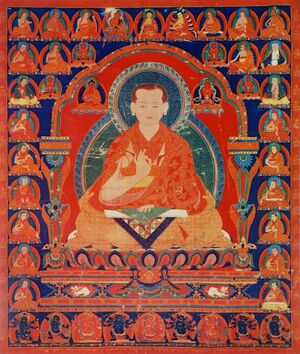No edit summary |
m (JeremiP moved page Topic of the week/Post-33 to Recent Essays/Post-33: Changing name) |
Latest revision as of 11:06, 29 April 2022
Rongtön and Buddha-Nature
Rongtön Sheja Kunrik alias Shakya Gyaltsen is one of the towering Sakya scholars who has left behind a rich corpus of commentaries on the five works of Maitreya. Among them, we find two works he composed pertaining to the Ultimate Continuum: a full commentary entitled Elegant Explanation of the Treatise of the Ultimate Continuum of the Mahāyāna and a short synopsis entitled Stages of Meditation of the Ultimate Continuum: Ornament of Maitreya's Intent, which contains instructions on how to put the Ultimate Continuum into practice. As one of the preeminent figures who shaped the philosophical assertions of the Sakya school, Rongtön presents a clear philosophical interpretation of the main topics discussed in the Ultimate Continuum.
For instance, while discussing the Buddha among the Three Jewels and explaining the unconditioned nature of the Buddha, Rongtön explains that the concept of being unconditioned must be understood in four different ways: not being conditioned by causes and conditions like the compounded phenomena are, not being conditioned by actions and afflictive emotions like ordinary sentient beings are, not being conditioned by the birth with mental body and inconceivable death and transfer like the enlightened saints on the path are, and not appearing to be conditioned like the physical forms of the Buddha are. Thus, only the aspect of the Buddha's ultimate state which is the sphere of reality or emptiness is truly unconditioned in the first sense; even the cognitive aspect of the Buddha's enlightenment is conditioned.
While commenting on Verses I.154 and 155, Rongtön refutes the interpretation given by former scholars and explains that there are no real adventitious defilements to be overcome, as they are empty by nature, and the defilements are separable from buddha-nature by their nature. Similarly, the natural purity of the buddha-nature need not be maintained, as it is an inherent and inseparable quality of the mind. Thus, he understands buddha-nature to be the luminous nature of the mind, combining both emptiness and awareness, and claims that it is free from truly existent defilements but endowed with the natural purity which unfolds into the sublime qualities of the Buddha when fully enlightened. If it were merely the unconditioned nature of emptiness, it could not be the main cause of Buddha's wisdom.
Although Rongtön presents in his commentary an analytical and scholarly exegesis of the Ultimate Continuum following the tradition passed down from the famous translator Ngok Loden Sherab, in his synoptic work on the practice of the Ultimate Continuum he lays out the structure in which this text can be put into practice. Firstly, one identifies the element/buddha-nature, which is the main cause of enlightenment, and the four obscuring thoughts and emotions, including aversion to dharma, view of self, fear of cyclic existence, and disregard for others' welfare. Then, one takes refuge in the Three Jewels to start the practice of the path to enlightenment and begins to cultivate the four antidotes to the four obscuring thoughts and emotions—namely, interest (seed), wisdom (mother), meditation (womb), and compassion (nanny). The path results in the state of enlightenment described as pure, self, permanent, and blissful. More on Rongtön’s commentary and the positions he held on buddha-nature and related topics can be read in Christian Bernert's Perfect or Perfected? Rongtön on Buddha-Nature.
Weekly quote
Mahāmati, what I taught as buddha-nature is not like the self advocated by the non-Buddhists. Mahāmati, what the fully enlightened Buddhas teach as buddha-nature refers to emptiness, the ultimate, nirvāṇa, the unborn, the uncharacterized, and the wishless.~ Laṅkāvatārasūtra

